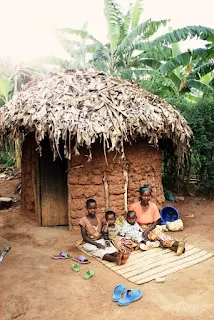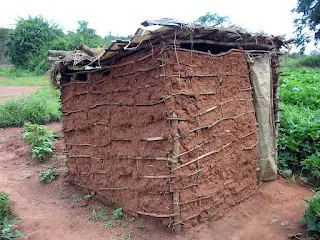Vernacular Architecture in three African countries:
Rwanda:
The fifth most densely populated country in the world. Ethnic tensions between Tutsies and Hutus erupted into a Civil War, in part driven by conflicts over access to land.
Is in the fertile, Great Rift Valley.
 |
| Is it any surprise that these people want to migrate to Developed Countries? |
 |
| A living fence |
 |
| Title of photo is "Kings Hut" |
Botswana
One of the most sparsely populated countries in the world. 20% of the population is infected with HIV according to one source.
 |
| Visitors are often amused that the builders have posts-and-wall holding up the roof. This kind of hut is very common in Africa. |
 |
| A dramatic example |
 |
| Looking at the lumber used in this construction, I conclude that they have Home Depot stores in Botswana. |
 |
| Fences are a big deal in Africa and highly variable. |
Mozambique
Beset with civil wars, Mozambique has been unable to capitalize on its centuries of exposure to Arab and Portuguese cultures.
More countries and photos HERE
Please keep the comments about Wakanda and "WWKs" to a minimum.










Africa....what can one say about it. Human are supposed to have evolved and become sentient there. Yet somehow the only advances that continent has seen have come from the outside and only in the past couple centuries.
ReplyDeleteThere are a lot of things in Africa that conspire against progress.
DeleteIt is hard to accumulate wealth and technology when rust-and-rot are so aggressive. It is hard to build human capital when disease is rampant (tsetse flies, mosquitoes, exotic virus and diseases).
Another factor is the high disease and insect pressure (heat, humidity, not freeze cycle) makes it difficult to engage in agriculture. The grain is subject to mold. And finally, African soil is is seldom renewed via volcanic additions and is highly leached of nutrients and depleted by erosion.
There are reasons why Africa is a frustrating continent with regards to being inhospitable to development.
There are a lot of people who think brick masonry home roofs are supported by the brick themselves. It is the wood stud adjacent to exterior walls and interior bearing walls which hold up the headers and joists supporting the roof structure above. Brick is simply making the exterior skin more durable - rot proof than wood cladding.
ReplyDeleteThe Mexican jacal is sort of similar to the construction above. It is funny how common the two room home is, one used for cooking, the other for sleeping, with a breezeway between the two rooms.
Thank you for the lessons above.
Back in my insurance selling days, I learned there is a big difference between a brick home and a brick veneer home. As mentioned above, most. “ brick homes” are wooden homes with a brick veneer and were risk rated as wooden homes.
DeleteThanks for sharing ERJ. Traditional architecture is always fascinating to me, although I have a limited understanding of design principles.
ReplyDeleteThey have a rough fence call a boma there. It's basically thorny limbs laid out in a spiral. I understand it confuses the predators and it is difficult to just push straight through. You can even "erect" one as a temporary / overnight protective barrier.
ReplyDeleteMuch to be learned from them. I was shocked at how few malaria deaths there were in Africa when DDT deployed. And how many are affected since.
Fewer people lived in known malarial areas in earlier centuries. Large parts of Africa were basically inhabitated. Africans simply learned over millennia...."don't go there"
Delete"UN-inhabitated"
DeleteThe Dutch colonists settled swampland in what is now called South Africa. The land didn't contain large animals nor did it support agriculture--even the Black Africans didn't live there (they hunted/fished the area) but didn't/couldn't settle it. The Whites, known as Boers (Dutch for "farmer") drained the land over centuries and turned swampland into rich, arable land where they could grow food crops as well as support livestock. When they discovered the plethora of precious minerals (diamonds, gold, silver, uranium, etc) the Brits took South Africa by force and established another British colony nearby that became known as Rhodesia (named after the explorer/merchant/soldier) who opened up that country and made it into the "Breadbasket of Africa". When the Brits left what is now called Zimbabwe in 1980--the country had everything Britain had--functioning railroads, hospitals, universities, schools, airports, roads, telecommunications (1980-vintage), a profitable mining industry, and the ability to feed itself and its neighboring countries--same thing for S. Africa with the addition of a burgeoning defense industry. I daresay that when the Whites entered these locations (S. Africa and Rhodesia) the technology/living standards were the same as the pics you've shown in your article--they're now reverting back to it since the Whites have left the place.
ReplyDeleteAverage IQ is ~70, so half of Africa is retarded, the other half isn't much better off. Those are pretty good for a bunch of 'tards.
ReplyDeleteThey'll never be able to build much better, and they'll never be able to maintain better if we build better for them.
o - A written language
ReplyDeleteo - Two story structures
o - The wheel.
I'll take "Things Africa never developed."
Delete